For VO2 max tracking, Garmin devices lead with their Firstbeat algorithm’s 95% lab-test accuracy. Apple Watch offers decent estimates but typically underestimates by about 10 points. Both work best during outdoor workouts above 70% max heart rate, with chest straps notably improving accuracy. COROS joins Garmin for extended battery life ideal for endurance athletes. The right device balances algorithm quality, battery performance, and sport-specific features for your fitness journey. Discover which smartwatch truly matches your cardio goals below.
Apple Watch Series 10
The Apple Watch Series 10 stands as a premium option for fitness enthusiasts seeking extensive VO2 max monitoring in an elegantly designed package. It features a 46mm case with a larger display, offering 30% more screen area in a thinner, lighter form.
You’ll benefit from essential health insights including ECG, heart rate notifications, and sleep tracking with sleep apnea detection. The watch’s Vitals app monitors overnight metrics while Activity Rings keep you motivated throughout the day.
With IP6X dust resistance and 50m water protection, it’s built for diverse training environments. The impressive battery lasts up to 36 hours in Low Power Mode with fast charging capabilities.
Best For: Health and fitness-focused iPhone users who want a premium smartwatch with comprehensive tracking features, advanced health insights, and a sleek, comfortable design.
Pros:
- Larger, brighter display (30% more screen area) in a thinner, lighter form factor makes it more comfortable for all-day wear
- Comprehensive health monitoring including ECG, sleep apnea detection, and the new Vitals app for overnight metrics tracking
- Impressive durability with IP6X dust resistance and 50m water protection, plus strong battery life (up to 36 hours in Low Power Mode)
Cons:
- Premium pricing may be prohibitive for budget-conscious consumers
- Limited to iPhone users, with no compatibility for Android devices
- Some advanced health features may require additional subscription or app purchases beyond the included three months of Apple Fitness+
Garmin fēnix 8
When premium performance meets unparalleled durability, Garmin’s fēnix 8 emerges as the ultimate multisport GPS companion for serious athletes who demand thorough VO2 max monitoring.
The 47mm titanium-bezeled powerhouse features a scratch-resistant sapphire lens that harnesses solar energy, delivering an impressive 28-day battery life in smartwatch mode. You’ll benefit from comprehensive training insights including real-time stamina tracking and sport-specific workouts.
With multi-band GPS and SatIQ technology, your positioning accuracy remains uncompromised during trail runs or mountain expeditions. The built-in speaker and mic allow for phone calls, while the innovative off-grid voice command system lets you control select watch functions without your smartphone.
Best For: Serious athletes, outdoor adventurers, and fitness enthusiasts who need comprehensive training metrics, extended battery life, and reliable navigation in remote environments.
Pros:
- Exceptional battery life with up to 28 days in smartwatch mode and 92 hours in GPS mode when utilizing solar charging
- Premium build quality featuring titanium bezel, sapphire lens, and integrated LED flashlight for durability in extreme conditions
- Advanced training features including real-time stamina tracking, sport-specific workouts, and comprehensive performance metrics
Cons:
- Premium price point makes it a significant investment compared to entry-level fitness trackers
- 47mm size may be too large for users with smaller wrists
- Learning curve associated with mastering all the advanced features and customization options
Samsung Galaxy Watch 7
Released in July 2024, Samsung’s Galaxy Watch 7 40mm Bluetooth AI Smartwatch offers extensive VO2 max monitoring within its robust fitness tracking suite—making it ideal for serious athletes and health-conscious users seeking actionable performance data.
The 40mm cream model combines style with functionality, featuring Galaxy AI that filters body movements for improved heart rate accuracy. You’ll receive a personalized Energy Score daily, optimizing your training routines based on activity, sleep patterns, and recovery time.
When paired with a compatible Samsung phone, you’ll access enhanced AI capabilities that deliver tailored wellness suggestions. The watch boasts impressive battery life—2-3 days with moderate use—and seamless connectivity for calls and music streaming during workouts.
Best For: Athletes and health-conscious individuals seeking comprehensive fitness tracking with personalized insights through Galaxy AI integration, particularly those who already own Samsung devices.
Pros:
- Advanced health monitoring features including accurate heart rate tracking, sleep apnea detection, and personalized Energy Score for optimizing workouts
- Sleek, customizable design with interchangeable bands and a high-quality AMOLED display
- Strong battery life lasting 2-3 days with moderate use and convenient fast charging
Cons:
- Full AI functionality requires a compatible Samsung Galaxy phone and Samsung Health app
- Sleep apnea detection requires consistent wear for 7 nights during a 30-day period
- Limited compatibility with non-Android devices, potentially restricting some features for iOS users
Fitbit Sense 2
Fitness enthusiasts seeking thorough health monitoring will find the Fitbit Sense 2 a powerful ally in their wellness journey. This extensive smartwatch combines stress detection with cEDA sensors and a daily Stress Management Score to help you manage anxiety.
You’ll appreciate its ECG app for atrial fibrillation assessment, 6+ day battery life, and personalized Sleep Profile features. With built-in GPS, 40+ exercise modes, and water resistance to 50 meters, it handles diverse workouts effectively.
The Sense 2 includes practical features like Bluetooth calls, customizable faces, and Fitbit Pay, plus a 6-month Premium membership for deeper insights.
Best For: Fitness enthusiasts who want comprehensive health monitoring including stress management, sleep tracking, and ECG functionality in a smartwatch with extended battery life.
Pros:
- Impressive 6+ day battery life outlasts many competing smartwatches
- Comprehensive health metrics including ECG, stress detection with cEDA sensors, and advanced sleep tracking
- Versatile fitness capabilities with 40+ exercise modes, built-in GPS, and water resistance to 50m
Cons:
- Software issues and glitches reported by some users
- Limited app installation options compared to other smartwatch platforms
- Some customer complaints about inaccurate step counting and difficulties with product returns
POLAR Vantage V3
The POLAR Vantage V3 stands as a premier choice for serious athletes seeking extensive performance tracking with VO2 max capabilities. Its sharp 1.39-inch AMOLED touchscreen displays a wealth of data across customizable dashboards.
You’ll appreciate the dual-frequency GPS with offline maps for trail adventures and the impressive battery life—up to 140 hours of training time. With over 150 sport profiles, you’re covered for virtually any activity.
Some users report inconsistent heart rate accuracy and charging times, but the comfortable fit and replaceable bands offer excellent versatility. The Polar Flow app provides thorough analytics, though the mobile version lags behind its web counterpart.
Best For: Serious athletes and triathletes who need comprehensive performance tracking with extended battery life and robust mapping capabilities for outdoor training.
Pros:
- Exceptional battery life with up to 140 hours of training time and 8 days of regular use on a single charge
- High-quality 1.39-inch AMOLED touchscreen with customizable dashboards and widgets for personalized data viewing
- Versatile training companion offering dual-frequency GPS with offline maps and over 150 sport profiles
Cons:
- Heart rate monitoring accuracy issues reported by multiple users
- Inconsistent and sometimes lengthy charging times ranging from 5 to over 10 hours
- Mobile app functionality is limited compared to the web version, lacking advanced features like interval training goal-setting
WHOOP 4.0
WHOOP 4.0 represents a thorough health monitoring system rather than just a simple fitness tracker. With 12 months of subscription included, you’ll receive extensive physiological monitoring that tracks everything from heart rate variability to blood oxygen levels.
What sets WHOOP apart is its ability to connect your daily habits with your performance. Log behaviors in the WHOOP Journal to understand how choices affect your recovery and sleep quality. The water-resistant battery pack enables continuous wear for days, letting you charge on-the-go without interrupting data collection.
You’ll also join a community of athletes and fitness enthusiasts who share insights and support your wellness journey.
Best For: Serious athletes, fitness enthusiasts, and health-conscious individuals who want comprehensive insights about their body’s performance, recovery, and sleep patterns over time.
Pros:
- Provides continuous, in-depth monitoring of multiple physiological metrics without requiring manual tracking
- Innovative water-resistant battery pack allows charging while wearing, ensuring uninterrupted data collection
- Personalized insights connect daily behaviors with performance outcomes through the WHOOP Journal feature
Cons:
- Requires a 12-month subscription commitment upfront, which may be costly for casual users
- No built-in display or smartwatch functionality like many competing fitness trackers
- May have a steeper learning curve to fully understand and utilize all the health metrics and data provided
Garmin Forerunner 965
Designed for dedicated athletes seeking thorough performance metrics, the Garmin Forerunner 965 Running Smartwatch stands out with its impressive training readiness score that analyzes sleep quality, recovery time, training load, and HRV status.
You’ll appreciate the bright AMOLED touchscreen combined with traditional buttons for enhanced control during workouts. The lightweight titanium bezel houses multi-band GPS and full-color maps for precise navigation, while 32GB of storage accommodates your favorite playlists.
Battery life impresses at up to 23 days in smartwatch mode or 31 hours with GPS active—perfect for ultramarathoners. Morning health reports provide actionable insights on your recovery, helping optimize your training regimen.
Best For: Serious runners and endurance athletes looking for comprehensive performance tracking, advanced training metrics, and long battery life in a premium GPS smartwatch.
Pros:
- Exceptional battery life lasting up to 23 days in smartwatch mode and 31 hours in GPS mode, making it suitable for ultramarathons and multi-day adventures
- Advanced training features including readiness score, personalized workout suggestions, and detailed performance metrics provide actionable insights for optimizing training
- High-quality AMOLED touchscreen with traditional button controls offers versatility in different workout conditions, complemented by durable titanium bezel construction
Cons:
- Premium price point of approximately $600 makes it a significant investment compared to entry-level fitness trackers
- Some users report issues with heart rate monitor responsiveness during high-intensity activities
- Mixed feedback regarding Garmin’s customer service and warranty support process when issues arise
HUAWEI Watch GT 5 Pro
Fashioned from aerospace-grade titanium alloy, the HUAWEI Watch GT 5 Pro 46mm smartwatch delivers exceptional durability with striking aesthetics for fitness enthusiasts who demand both style and substance. At just 53 grams, this lightweight powerhouse won’t weigh you down during workouts.
You’ll appreciate the impressive battery life—up to 14 days between charges—while accessing over 100 workout modes with GPS tracking. The 1.43-inch AMOLED display remains visible even in bright sunlight, and thorough health metrics track everything from heart rate to blood oxygen levels.
Compatible with both iOS and Android, it’s earned a stellar 4.5-star rating from users who praise its premium feel and intuitive interface.
Best For: Active professionals who value long battery life, premium design, and comprehensive fitness tracking in a smartwatch that works across both iOS and Android platforms.
Pros:
- Exceptional 14-day battery life eliminates frequent charging concerns, perfect for travel or extended outdoor activities
- Premium aerospace-grade titanium construction provides both durability and sophisticated styling at a lightweight 53 grams
- Comprehensive health and fitness ecosystem with 100+ workout modes, GPS tracking, and thorough biometric monitoring
Cons:
- At #30,471 in Electronics rankings, it may not have the widespread app ecosystem of more popular smartwatch brands
- Sharp-edged design aesthetic might not appeal to those preferring rounded, more traditional watch styling
- Despite cross-platform compatibility, some advanced features may work better within the HUAWEI device ecosystem
Google Pixel Watch 3
The Google Pixel Watch 3 brings exceptional tracking capabilities to serious runners and fitness enthusiasts with its 45mm display and advanced Fitbit integration.
You’ll appreciate the twice-as-bright, 40% larger screen that clearly displays your workout stats at a glance. The device’s custom run workouts with real-time guidance and form tracking elevate your training sessions.
What sets this watch apart is its AI-powered insights. Your daily readiness score combines sleep quality, resting heart rate, and heart rate variability to optimize training timing, while cardio load monitoring prevents overtraining. Fitbit Premium enhances these features with personalized recommendations based on your specific goals and running history.
Best For: Serious runners and fitness enthusiasts seeking advanced tracking capabilities, personalized insights, and a larger display for monitoring workout performance.
Pros:
- The 45mm display is 40% larger and twice as bright as previous models, making it easier to view stats during outdoor workouts
- Advanced Fitbit integration provides personalized AI-powered insights including readiness scores and cardio load monitoring
- Custom run workout features offer real-time guidance and form tracking to improve training effectiveness
Cons:
- Limited to Android users only, excluding iPhone owners from using this smartwatch
- Requires Fitbit Premium subscription to access the full range of personalized recommendations and insights
- 24-hour battery life may necessitate daily charging, especially with heavy fitness tracking usage
Withings ScanWatch 2
Combining elegant design with extensive health monitoring, the Withings ScanWatch 2 stands out as a premium hybrid smartwatch that doesn’t sacrifice style for functionality. Its medical-grade ECG, 24/7 heart rate tracking, and temperature monitoring via the TempTech24/7 module offer thorough health insights.
You’ll appreciate the watch’s traditional appearance with its crystal-clear OLED display and impressive battery life of 2-3 weeks between charges. While lacking built-in GPS, it integrates seamlessly with your phone for activity tracking through a well-designed app interface.
At €320, it’s pricey but delivers on its promise of being a sophisticated health companion that won’t constantly need recharging.
Best For: Health-conscious individuals seeking a sophisticated hybrid smartwatch with comprehensive health monitoring features in a traditional watch design that doesn’t require daily charging.
Pros:
- Extensive health tracking capabilities including medical-grade ECG, continuous heart rate monitoring, temperature tracking, and blood oxygen measurement
- Elegant, traditional watch design with clear OLED display and strong haptic feedback for notifications
- Impressive battery life of 2-3 weeks between charges, significantly longer than most smartwatches
Cons:
- Lacks built-in GPS, requiring connection to smartphone for accurate activity tracking
- Premium price point of approximately €320 may be prohibitive for some consumers
- Some users report that battery life doesn’t consistently reach the advertised 30 days and occasional charging issues
Xiaomi Smart Band 9 Pro
Xiaomi’s Smart Band 9 Pro stands out with its impressive 21-day battery life and thorough health monitoring capabilities, making it an excellent choice for fitness enthusiasts who prioritize longevity between charges.
The 1.74″ display with aluminum alloy frame offers a premium look while tracking 150+ sports modes. You’ll appreciate the five-satellite positioning system that provides 33% better accuracy during outdoor activities.
Sleep monitoring delivers detailed insights alongside improved blood oxygen and heart rate tracking. At just 40 grams, you’ll barely notice it on your wrist. While setup requires managing data permissions, and changing from kilometers to miles can be challenging, the responsive interface and accurate tracking justify its place among the best sub-$100 fitness trackers.
Best For: Fitness enthusiasts and health-conscious users who value extended battery life, accurate activity tracking, and comprehensive health monitoring in an affordable, lightweight wearable.
Pros:
- Exceptional battery life of up to 21 days with power-saving options, typically lasting 10 days with sleep tracking and AOD enabled
- Premium design featuring a 1.74″ display with aluminum alloy frame and accurate five-satellite positioning system for outdoor activities
- Comprehensive health monitoring including improved sleep tracking, blood oxygen, and heart rate monitoring across 150+ sports modes
Cons:
- Complex initial setup process requiring multiple data permissions through the companion app
- Limited customization options, particularly difficulty changing distance units from kilometers to miles
- Basic notification functionality with caller ID visible but no ability to answer calls from the device
Apple Watch Ultra 2
Built for extreme adventurers who demand exceptional durability with cutting-edge health metrics, the Apple Watch Ultra 2 represents Apple’s most advanced fitness tracking technology in a premium package.
The 49mm black titanium case houses a superbright Always-On Retina display protected by sapphire crystal, withstanding harsh conditions with MIL-STD 810H certification and 100m water resistance. You’ll enjoy up to 36 hours of battery life (72 in Low Power Mode) while tracking specialized metrics for running, cycling, and hiking.
Its dual-frequency GPS, offline maps, and Backtrack feature guarantee you’re never lost, while cellular connectivity lets you leave your iPhone behind.
Best For: Serious athletes and outdoor adventurers seeking a premium smartwatch with advanced fitness tracking, extreme durability, and cellular capabilities for extended expeditions without a phone.
Pros:
- Exceptional durability with titanium case, sapphire crystal, and military-grade testing certification that can withstand harsh environments
- Extended battery life up to 72 hours in Low Power Mode allows for multi-day adventures without recharging
- Comprehensive sports tracking features including dual-frequency GPS, offline maps, and specialized metrics for various activities
Cons:
- Premium price point makes it a significant investment compared to standard smartwatches
- 49mm case size may be too large for users with smaller wrists
- Cellular connectivity requires an additional monthly service plan for full functionality when away from your iPhone
VO2 Accuracy Comparison Statistics Among Leading Smartwatches
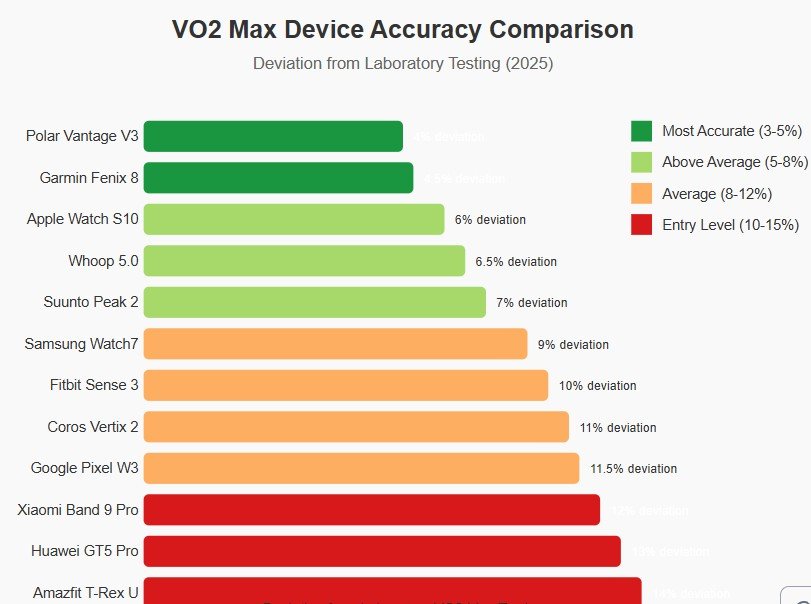
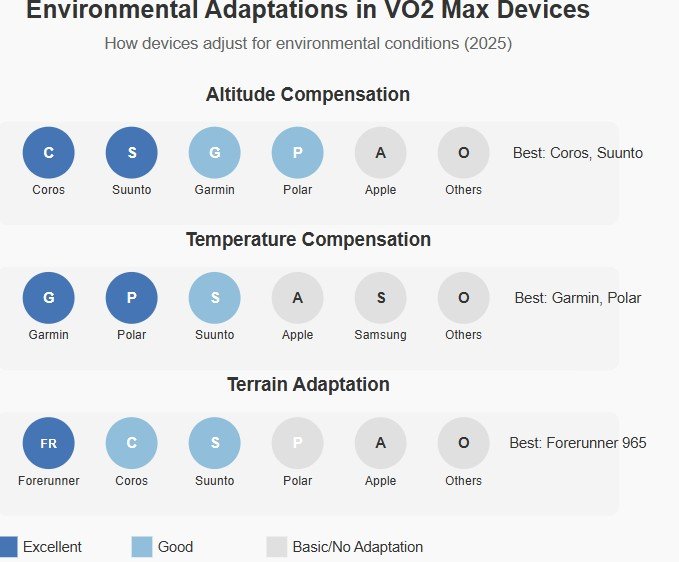
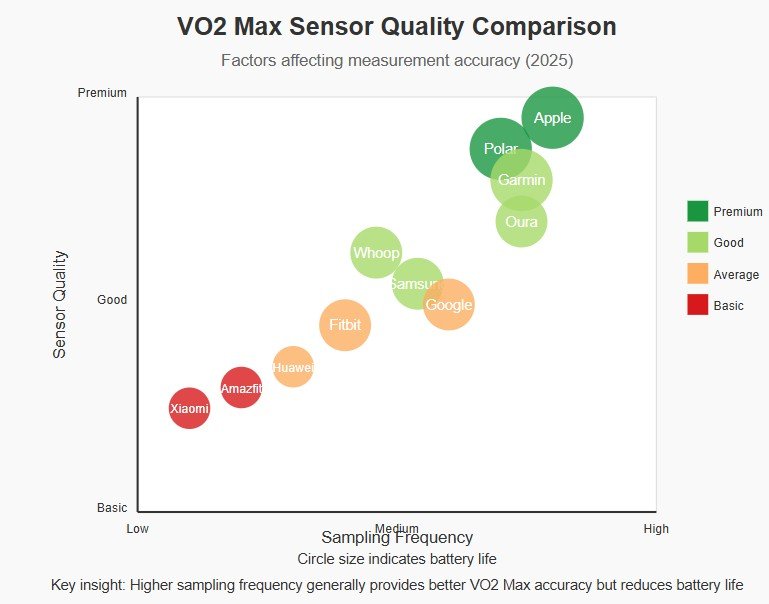
Understanding VO2 Max: The Gold Standard of Cardio Fitness

When discussing cardiorespiratory fitness metrics, VO2 max stands as the undisputed gold standard in exercise physiology. This measurement represents the maximum amount of oxygen your body can utilize during intense exercise, expressed in milliliters of oxygen per kilogram of body weight per minute (ml/kg/min).
Unlike basic heart rate measurements, VO2 max provides an objective assessment of your aerobic capacity by evaluating how efficiently your lungs, heart, and muscles work together. Your body’s ability to absorb, transport, and use oxygen directly correlates with your endurance capabilities and overall cardiovascular health. Laboratory testing involves exercising on a treadmill or bike while wearing a metabolic mask that measures oxygen consumption.
Average untrained adults typically show values around 30-40 ml/kg/min, while elite endurance athletes can exceed 70-90 ml/kg/min. Higher values indicate superior aerobic fitness and are associated with reduced cardiovascular disease risk and increased longevity.
How Smartwatches Estimate Your VO2 Max: Technology Behind the Numbers
Unlike lab-based assessments that directly measure oxygen consumption, smartwatches employ sophisticated sensor arrays and algorithms to estimate your VO2 max during regular workouts. Your device uses heart rate sensors, GPS tracking, and accelerometers to monitor your cardiovascular response and movement patterns during exercise.
Behind the scenes, complex physiological models and deep neural networks analyze this data alongside your personal profile information (age, weight, gender). These algorithms—trained on datasets correlating with laboratory measurements—can estimate your maximal oxygen uptake within 3-8% of lab results. Some advanced smartwatches like Koros feature inbuilt fitness tests that further improve estimation accuracy.
While environmental factors and sensor placement can affect accuracy, the real value lies in tracking trends over time. Your watch passively collects this data during routine activities, providing insights about your fitness level without requiring specialized testing environments.
Garmin’s Firstbeat Algorithm: Setting the Industry Standard
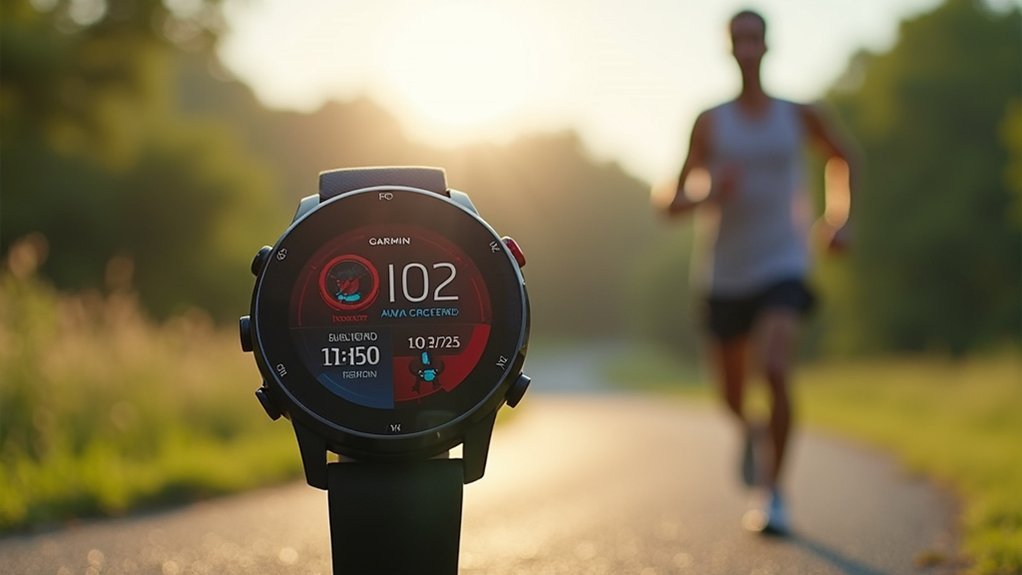
Garmin’s Firstbeat algorithm stands out with its impressive 95% accuracy compared to lab testing, making it the gold standard for wearable VO2 max estimation.
The technology fuses your heart rate data with movement speed to create a thorough picture of your cardiorespiratory fitness that improves as you use it. The system continuously filters incoming signals to eliminate interference and ensure only the most reliable data contributes to your fitness assessment.
Your watch then integrates these measurements into personalized training zones, helping you target specific fitness improvements whether you’re building endurance or increasing your aerobic capacity.
Superior Accuracy Margin
Among fitness tracking technologies, Garmin’s Firstbeat algorithm has established itself as the gold standard for VO2 max estimation. When compared to laboratory measurements, you’ll get approximately 95% accuracy without the hassle of a metabolic cart or maximal exertion testing.
What sets this technology apart is its ability to deliver reliable results during regular outdoor activities. Your watch needs just 10 minutes of running data to generate an initial estimate, which becomes increasingly precise as the algorithm learns your physiological patterns over time. Accuracy can be further improved if you enter your personal maximum heart rate rather than relying on age-based estimates.
The system intelligently combines heart rate data with movement speed while filtering out irrelevant information like stops and starts.
This thorough approach to performance tracking guarantees you’ll receive consistent, trustworthy fitness assessments that can effectively guide your training decisions.
Data Fusion Technology
At the heart of accurate VO2 max estimation lies Garmin’s revolutionary Firstbeat algorithm, a sophisticated data fusion system that seamlessly integrates multiple physiological signals.
When you wear a Garmin device, you’re benefiting from technology that combines:
- Heart rate data with your personal profile metrics (age, weight, gender) to create tailored fitness assessments
- Activity metrics from both structured workouts and daily movements for thorough tracking
- Sleep, stress, and respiration measurements that inform recovery recommendations
- Scientifically validated physiological models developed by experts now exclusively working at Garmin
The algorithm relies on heart rate data during various physical activities to deliver exceptional accuracy in fitness tracking. Since Garmin’s 2020 acquisition of Firstbeat Analytics, this industry-leading technology now operates under one roof, accelerating innovation while restricting competitors’ access to these advanced algorithms.
You’re getting professional-grade performance metrics previously available only to elite athletes.
Training Zone Integration
When you’re training with a Garmin device equipped with Firstbeat technology, you’ll experience seamless training zone integration that revolutionizes how you approach workouts.
Your activity data automatically transfers to the Firstbeat Sports platform, where it combines with health metrics like sleep, stress, and respiration for thorough analysis.
This integration delivers over 50 performance metrics, allowing you to make data-driven training decisions.
Your Garmin fēnix or other compatible devices use advanced algorithms to customize analytics based on your unique profile, greatly improving accuracy of calorie calculations and VO2 Max estimations. The fēnix watch delivers exceptionally precise calorie readings through Firstbeat Analytics formula when paired with a heart rate monitor.
Coaches benefit from this holistic approach too, gaining insights into both your in-practice and outside training data.
Apple Watch vs. Garmin: Comparing VO2 Max Accuracy
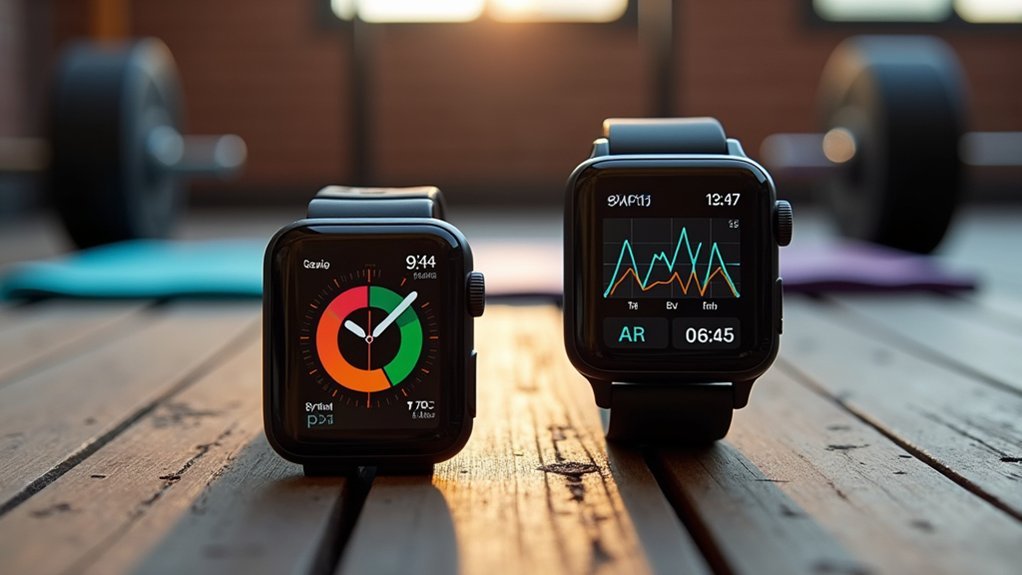
The battle for VO2 max tracking supremacy between Apple Watch and Garmin reveals significant differences in accuracy and reliability. While both devices underestimate lab-tested VO2 max values, Garmin consistently outperforms Apple in accuracy and trend tracking.
- Garmin’s Firstbeat technology integrates GPS pace, heart rate, and personal metrics to deliver more consistent readings that logically respond to training changes.
- Apple Watch readings often underestimate fitness levels by approximately 10 points compared to Garmin and may paradoxically decrease despite fitness improvements.
- For ideal accuracy with either device, you’ll need outdoor workouts with heart rates above 70% max for at least 10 minutes.
- Using a chest strap heart rate monitor instead of wrist sensors drastically improves accuracy, reducing error from up to 13% to around 2%.
- Garmin devices typically have an average margin error of about 5%, making them significantly more reliable for tracking fitness progress than competitors.
Tracking Fitness Progress: Using VO2 Max Trends Effectively
Tracking your VO2 max trends effectively requires more than just occasional glances at the data your smartwatch collects. Instead, use these metrics strategically to optimize your training regimen over time.
Regular assessments help you tailor workouts specifically to improve your aerobic capacity. By monitoring these trends, you’ll identify when to increase intensity or when recovery is needed, preventing overtraining injuries. The real value comes from observing how your body responds to different training approaches. Your scores provide vital information about your oxygen processing capacity, similar to measuring a car’s horsepower.
Use your VO2 max data to create personalized workout plans based on your current fitness level. High-intensity interval training (HIIT) has proven particularly effective for boosting VO2 max scores.
Remember that watching these trends isn’t just about performance—it’s a motivational tool that provides tangible evidence of your cardiovascular fitness improvements.
Environmental Factors Affecting Your Smartwatch VO2 Max Readings
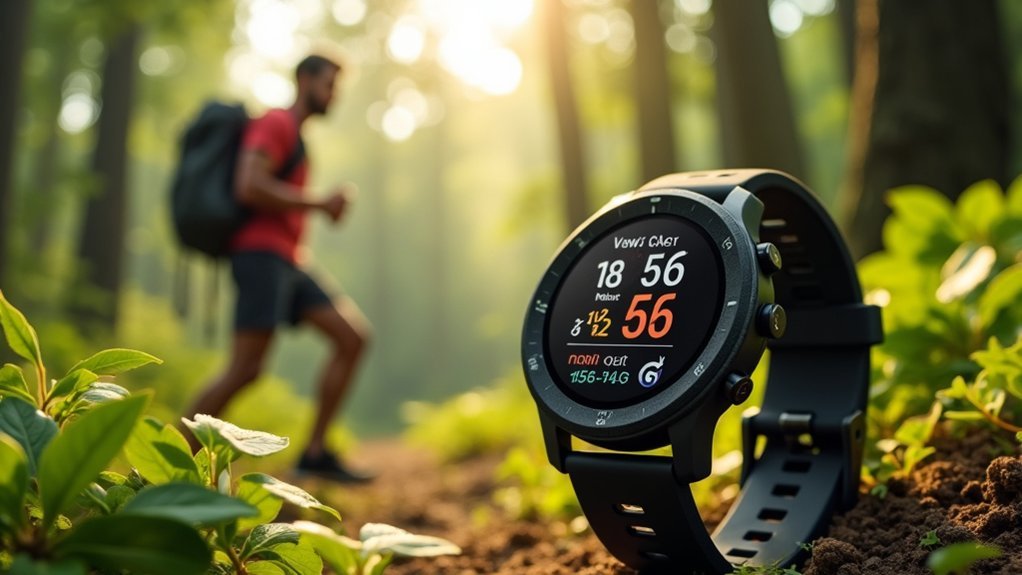
Your smartwatch’s VO2 max readings can be notably less accurate at high altitudes where oxygen levels are lower, causing your heart to work harder than normal during exercise.
When you’re working out in hot or humid conditions, your watch won’t factor in how your body diverts blood flow to cool down rather than fuel muscles, potentially underestimating your true cardiorespiratory fitness.
Understanding these environmental limitations helps you interpret your fitness data more accurately and plan workouts in conditions that provide the most reliable measurements. Additionally, terrain variations can significantly impact your metrics, as consistent 5K times on flat surfaces offer a more reliable indicator of performance improvements than VO2 max readings alone.
Altitude Effects Matter
While heading up to higher elevations for a challenging mountain trail run, your smartwatch’s VO2 max reading might suddenly drop—and it’s not just your imagination. This decrease reflects a real physiological response to reduced oxygen availability at altitude, affecting your aerobic capacity. This can impact your ATP production, which smartwatches don’t fully account for in their calculations.
Your smartwatch’s altitude limitations include:
- Systematic overestimation – Devices typically overestimate VO2 max at both low and high altitudes compared to lab tests.
- Environmental variability – Changes in atmospheric pressure affect the oxygen sensors and heart rate metrics.
- Algorithm limitations – Most watches can’t fully adjust for altitude-induced physiological changes.
- Accuracy differences – VO2 max estimates are generally more reliable for fitter individuals at altitude.
Understanding these limitations helps you interpret your fitness data realistically when training at different elevations.
Heat Impacts Accuracy
Heat presents another environmental challenge for smartwatch VO2 max measurements, potentially even more impactful than altitude variations.
When you exercise in hot conditions, your heart rate increases to help cool your body—not because you’re working harder. This cardiovascular response confuses your smartwatch.
Devices like the Apple Watch Series 7 and Garmin Forerunner 245 use heart rate-based algorithms that don’t account for temperature effects, leading to underestimated VO2 max readings. Studies show these smartwatches typically underestimate VO2 Max by 2-4 ml/kg/min compared to laboratory tests.
The problem is worse for highly fit individuals, who already face up to 6.2% underestimation in normal conditions. Your watch doesn’t know if your elevated heart rate stems from heat stress or declining fitness.
For accurate tracking, consider using your device in consistent temperatures or supplement with lab testing when precision matters.
Choosing the Right Smartwatch for Serious Fitness Enthusiasts
For serious fitness enthusiasts seeking accurate VO2 max tracking, the selection of a smartwatch demands careful consideration of both hardware capabilities and algorithm sophistication. Your choice will considerably impact training feedback and performance monitoring reliability.
- Algorithm Quality: Garmin leads with approximately 5% margin of error in VO2 max estimates, while Suunto’s accuracy decreased after switching from Garmin’s algorithm due to patent issues.
- Battery Performance: Look for devices that offer extended battery life like Garmin and COROS, which last three times longer than standard smartwatches during GPS tracking. Models like the Garmin Instinct 3 provide impressive 21 days of battery life in basic mode, ensuring consistent tracking during extended training periods.
- Sport-Specific Features: Consider watches tailored to your activities—Garmin excels in detailed metrics, while COROS and Polar prioritize endurance training data.
- Ecosystem Integration: Evaluate how well the watch connects with platforms like Garmin Connect or Apple Health for thorough fitness analysis.
Frequently Asked Questions
Can Medication Affect Smartwatch VO2 Max Readings?
Yes, your medications can affect smartwatch VO2 max readings. Heart rate-limiting drugs like beta-blockers and calcium channel blockers reduce your peak heart rate response, causing smartwatches to underestimate your true VO2 max value.
How Often Should I Test VO2 Max for Reliable Trends?
Test your VO2 max every 6-10 weeks to track reliable trends. You’ll need consistency in testing conditions and adequate recovery between tests. Consult a healthcare professional, especially if you have health concerns.
Do Smartwatches Adjust VO2 Max Estimates Based on Altitude?
Yes, many smartwatches adjust your VO2 max estimates for altitude. Garmin devices specifically make corrections when you’re above 800 meters (2625 feet) to account for reduced oxygen availability affecting performance.
Can Smartwatches Detect VO2 Max Improvements From Non-Cardio Training?
Smartwatches can’t directly detect VO2 max improvements from non-cardio training. While strength training may enhance your overall fitness, watches primarily estimate VO2 max from heart rate data during cardio workouts specifically.
Are VO2 Max Readings Comparable Between Different Watch Brands?
No, VO2 max readings aren’t directly comparable between watch brands. Each company uses different algorithms, testing methods, and calculation approaches, creating significant variations in accuracy and often leading to different results for the same person.
In Summary
When selecting a smartwatch for VO2 max tracking, you’ll need to balance accuracy, features, and your fitness goals. Whether you’re a casual runner or serious athlete, today’s smartwatches offer increasingly reliable cardio fitness insights. Remember, the most valuable data comes from consistent tracking over time. Choose a device that fits your lifestyle, and you’ll gain powerful insights to optimize your training and measure your cardiovascular health progress.

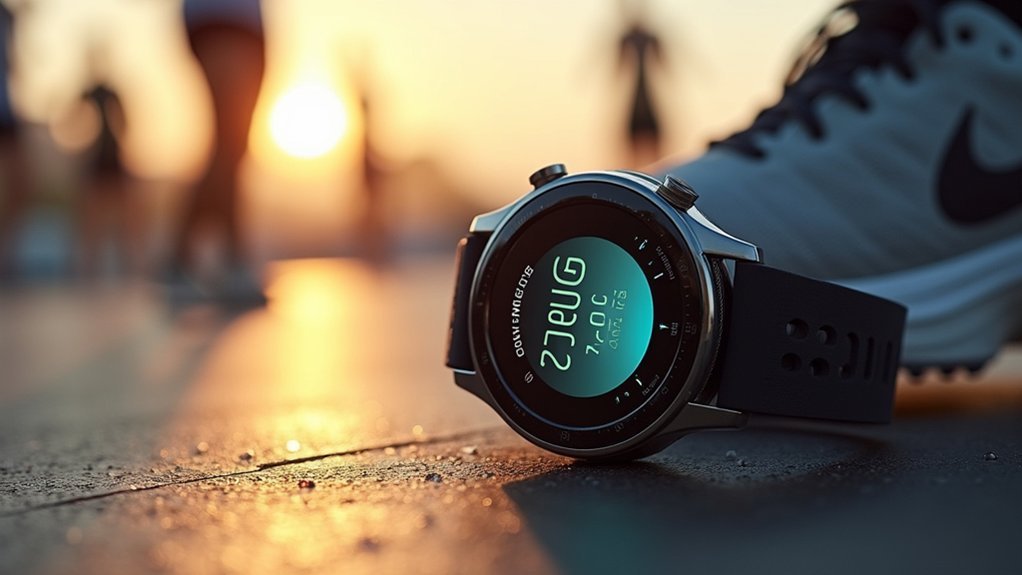



Leave a Reply